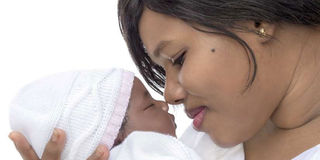New way to prevent mother-to-baby HIV transmission

Human babies born of HIV-positive mothers typically take the drug cocktail — a personalised regimen of multiple drugs taken daily — for about six weeks before being retested. PHOTO | FOTOSEARCH
A newborn getting a single dose of an antibody-based treatment 30 hours after being exposed to HIV can prevent transmission from mother to baby, a study has shown.
The research, conducted by two researchers from the Oregon Health & Science University School of Medicine, showed that monkeys’ infants did not develop the monkey version of HIV — called SHIV — when they were given the antibody within that period.
The research, involving a species of monkeys in Africa and Asia, published early this week in the journal Nature Communications, termed the findings “first in the non-human primate research”. A single dose of broadly neutralising antibodies given after viral exposure was found to prevent SHIV in primate newborns.
Delaying treatment until 48 hours, on the other hand, resulted in half of the baby monkeys developing SHIV when they were given four smaller doses of the same antibody cocktail.
In comparison, the study found monkeys that received the current standard HIV treatment — antiretroviral drugs — remained SHIV-free when they started a three-week regimen of that therapy 48 hours after exposure.
In a presser published at Oregon’s University website, Dr Nancy Haigwood, one of the authors, said: “These promising findings could mean babies born to HIV-positive mothers can still beat HIV with less treatment".
Human babies born of HIV-positive mothers typically take the drug cocktail — a personalised regimen of multiple drugs taken daily — for about six weeks before being retested. If the tests are then positive, they likely need to take HIV drugs for the rest of their lives. But, this study showed primate newborns didn't have SHIV after undergoing antiretroviral therapy for just three weeks starting 48 hours after exposure.
VIRAL LOAD
Plasma Viral Load (PVL), the term used to describe the presence of a certain amount of viruses in the plasma, is also tested. When it is positive, it can also mean the person can infect others.
Daily antiretroviral therapy (ART), which is giving the patient ARVs and is the standard care globally, is able to reduce the PVL to levels that cannot be detected, meaning the person cannot infect others.
However, even in those undetectable levels, treatment has to continue because when it is interrupted, the viral load rebounds.
Previous research by the same team that has just published showed four doses of antibodies started 24 hours after exposure prevented SHIV infection, with all 10 of the baby primates in that study not having any virus for six months. Both studies used a combination of two antibodies called PGT121 and VRC07-523.
Nonetheless, post-exposure prophylaxis with ART within 72 hours of exposure can reduce the likelihood of infection, although efficacy wanes the longer the treatment is delayed.
This research would benefit Kenya, one of the countries that the UN body tasked with coordinating Aids response, UNAids, terms high burden for paediatric HIV.
According to the National Aids Control Council (NACC), 53,236 women with HIV received ARV prophylaxis to prevent transmission to their newborns in 2017. This, NACC said, represents about 77 per cent of need.
About 132,300 child HIV infections have been averted through to 2017 due to prevention of the mother to child transmission (PMTCT) scale up since 2004.
Perhaps due to poor adherence or lack of access to care, an estimated 471,800 child infections have occurred throughout the HIV epidemic till 2017.


